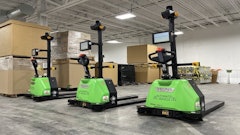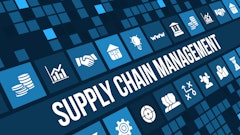
As everyone knows, the supply chain is in constant flux, with new and complex challenges always appearing. Transportation Management Systems (TMS) in the food and beverage sector may be even more involved, with cold chain, e-commerce, online groceries and increasing compliance issues complicating things.
Food industry supply chains have to juggle multi-stop loads, combine less-than-truckload (LTL) into full truckload (TL)—consolidating different customer’s freight on the same load, all while meeting regulations.
“Tracking and visibility of freight movements, as well as the accuracy of documentation, is no longer ‘nice to have,’ it’s required,” insists JP Wiggins, co-founder and vice president of logistics at Shelton, Connecticut-based 3Gtms.
Outdated Processes an Advantage
For some food and beverage companies, efficiency may be difficult to achieve because—as hard as it is to believe—many are still are using spreadsheets.
“The No. 1 tool is still Excel; yet, the business is getting more complex,” Wiggins says. “They’re facing more needs from the customer side. Customers are expecting more and better service, [even from] an IT perspective, [but] they’re stuck in an industry that’s still highly manual.”
That changing landscape, however, is beneficial to the TMS providers, notes Dan Sellers, CEO of 360data in Appleton, Wisconsin. He sees three areas where a TMS can make a difference: routing, execution and analytics.
“Routing means having the right carriers on the right route. Execution means integrating the system into your EDI, and business analytics means understanding the performance and management of your carriers,” he says. “You’ve got the data mined to help you drive those decisions.”
The trend toward consumer demand and e-commerce has caught the attention of Sean Guzik, senior solutions architect at Cary, North Carolina-based MercuryGate. “Mail-order food like [ingredient-and-recipe meal kit provider] Blue Apron are now getting involved in the marketplace,” he notes. “That’s making us think about our distribution facilities and what the network model should be made up of.
“Customers want visibility; they want to see their product move through the chain,” Guzik adds. “How are shippers changing their supply chains to adapt from supporting heavily processed food with a long shelf life to shipping fresh foods, especially since consumers are also looking the source of the foods for environmental responsibility?”
Stepping away from spreadsheets to automated TMS technology is making a difference, says Wiggins, noting that return on investment (ROI) is achievable via automation and cost control. “As technology evolves, it becomes simpler and easier to install. There are many proven success stories with fast—less than one year—ROI. Even simple, full truckload execution should be automated, and there is cost savings to doing so. Automate simple tasks, capture better data and use the data for analysis on how to improve.
“Food distribution companies are now being judged more on the quality of their technology and IT abilities to deliver information, not just freight,” he adds.
Sellers says that, from a TMS perspective, “not all of your issues can be solved, but there is software to integrate into the TMS itself. Best practices are driven by your customers. Each has different requirements, and you have to comply. A good TMS will have that compliance.”
It’s the Law
Both the Food Safety Modernization Act (FSMA) and the Electronic Logging Device (ELD) mandate are forcing food manufacturers, shippers and third-part logistics providers (3PL) to ensure that their carriers are compliant.
FSMA came about because, according to the Centers for Disease Control and Prevention (CDC), about 48 million people (1 in 6 Americans) get sick, 128,000 are hospitalized, and 3,000 die each year from food-borne diseases. This is a significant public health burden that is largely preventable. That caused the U.S. Food & Drug Administration (FDA) to create the act, intended to ensure the U.S. food supply is safe by shifting the focus of federal regulators from responding to contamination to preventing it.
The ELD rule was implemented by the Federal Motor Carrier Safety Administration (FMCSA). It requires ELD use by commercial drivers who are required to prepare hours-of-service (HOS) records of duty status (RODS). It sets ELD performance and design standards, and requires ELDs to be certified and registered with FMCSA. In addition, it establishes what supporting documents drivers and carriers are required to keep and prohibits harassment of drivers based on ELD data or connected technology (fleet management systems, for example) and provides recourse for drivers who believe they’ve been harassed.
“The impact of the FSMA and other regulations is significant,” Sellers says. “One result is that shippers need to articulate the proper handling conditions and requirements for the product being moved. Are the carriers prepared to validate these requirements and/or do they need to be able to do this? People knew FSMA was coming.”
And, asks Guzik, how are shippers and 3PLs ensuring that the carriers they choose are compliant? In turns, those carriers also have an onus on them because of the ELD. Many observers think the rule will make an already critical driver shortage even worse.
“Capacity is expected to decrease because some drivers are saying they will leave the industry, rather than comply,” Guzik says. “How can food logistics shippers obtain needed capacity with the specialized equipment required for this industry? A lot of shippers want some type of carrier management software [with their TMS], so they know if they assign a load to a non-compliant carrier, they’ll be able to stop it and shift to a compliant carrier.”
Other expenses that occur because of new regulation include training, technology, driver pay, administrative costs and more. “Where are the efficiencies in the supply chain to offset or slow those rising costs?” asks Sellers.
Things to Think About
The integration of available software into a TMS system needs to be quick. What used to take years, now needs to be done in a couple of weeks or less, but it takes research to discover the right software to help you meet the needs of your customers.
TMS is coming out with simple solutions that are rapidly implemented, cheaper and up front. Wiggins suggests looking at case studies from other companies to gage their experiences. “We’re not Amazon, and you’re not Amazon, but customers expect the same kind of speed [and simplicity.] You have to hide the complexity from the customer,” he adds.
Guzik agrees, noting it’s all about usability. “Make it simpler and quicken each process. Look at use cases and successes. Is the TMS vendor strong in your success categories? Understand your customer’s requirements, what’s important to them for TMS. Find the strengths and weaknesses of each TMS. Velocity is the key. People want to get live as soon as possible.”
Sellers adds, “Best practice is driven by your customers. Each has different requirements, providers must comply with.
“Start with your primary distribution channel targeted toward and looking at TMS suppliers who have strength and history in understanding what those distribution channels require to do business with them,” he advises.














![Pros To Know 2026 [color]](https://img.sdcexec.com/mindful/acbm/workspaces/default/uploads/2025/08/prostoknow-2026-color.mduFvhpgMk.png?ar=16%3A9&auto=format%2Ccompress&bg=fff&fill-color=fff&fit=fill&h=135&q=70&w=240)




